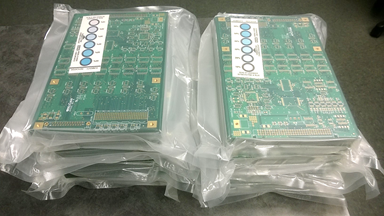No More Silica: Startup Believes It Has Better Answer to Keeping Boards Dry
TAMPA, FL – Moisture is the bane of the circuit board, and millions of dollars are spent on packaging materials each year to keep parts dry. But while components can be packaged and handled in trays, standard practice remains to treat each PCB as an individual unit, storing them with silica gel desiccant bags to soak up unwanted moisture.
Dan Jenkins, CEO of startup company Steel Camel, says it’s past time to move on from inexpensive and relatively ineffective silica gel bags. Industry standards, however, must be brought up to date, he adds.
“Industry specifications are quite confusing and complicated, because the military spec MIL-D-3464 is way out of date, and the test devices don’t exist to the public or even branches of military,” notes Jenkins. “And while the far majority of suppliers of desiccant beads claim they pass the mil spec, they cannot prove they meet it and have never submitted to the military for qualification. Military equipment manufacturers are only requiring manufacturers to meet the spec, so everyone is using a silica gel desiccant which does not work that well and is most likely not qualified under the MIL-D-3464.”
Steel Camel’s patented technology relies on a water-absorbent packet made of sheets of a cotton fabric through which moisture can penetrate. Once it does, the water is absorbed by a sodium poly-2-propenoate (sodium salt) compound.
A company video (youtube.com/watch?v=kli3OMrFUD4) tells the story: The introduction of the novel desiccant turns 8oz. of water into a solid block in about 45 sec.
Common silica gel desiccant bags cost 25 to 30 cents in the US and eight to 12 cents in China, Jenkins says. Because the quality of the Chinese-made bags can be poor, some US companies will buy silica gel bags in the US and ship them to China in 55-gal. drums. A similar size bag of Steel Camel is 10 to 15 times the cost, Jenkins allows. “We desiccate much, much more volume of air, however, and we do it more effectively!”
Indeed, in testing performed by Channelview, TX-based Standard Testing Laboratories, a report from which was shared with PCD&F/CIRCUITS ASSEMBLY, the novel desiccant performed far superior to silica gel.

Sample packing of boards, in which each board is individually wrapped and each package has both a desiccant bag and a humidity card. These bags are then vacuumed-sealed.
In STL’s tests, 10g each of silica gel granules and the novel desiccant were placed in separate beakers and titrated with water until the first indication of free water was observed. Silica gel showed visual free water after 13ml of added water, while the novel desiccant did not have free water even after 2000ml of water was added. In a separate test of condensate formation using sealed one-gallon jars containing 10g of the respective desiccants and 20ml of water, the jars were temperature-cycled from 40° to 75°F on a daily basis for a week. The silica gel granules showed condensate formation each day; the novel desiccant showed no condensate formation at all.
The de facto standard practice at many companies is to individually wrap each board with a desiccant bag and humidity card. The bags are then vacuumed-sealed, which, Jenkins points out, can trap in moist air.
Steel Camel’s bag has a simple seal, which eliminates the vacuum step. It also accommodates more boards per packaging, thus improving economies-of-scale and reducing packaging waste.
Another difference between traditional silica gel bead and Steel Camel is the indicator. The Silica Gel is rigid; therefore, a color indicator is used to help determine when to change. The Steel Camel bags expand from a flat pillow to a blown-up pillow, so visual and feel inspection techniques are used during inspection to determine when to change.
One multinational fabricator is testing Steel Camel’s technology by putting 15 to 20 boards in a bundle, loosely wrapped, and adding the novel absorbent. Jenkins is actively looking for additional companies to conduct comparison tests; contact him at djenkins@steelcamel.com.
Press Releases
- 2026 IEEE Electronic Components and Technology Conference Student Innovation Challenge Pre-registration Deadline Extended to January 11, 2026
- PCBsync PCB Assembly Introduces Full-Scale Electronic Manufacturing Service
- Magic Leap Partners with Pegatron for AR Glasses Components Production
- TEXMAC/Takaya Appoints ARK Mfg. as New Rep in Arizona







